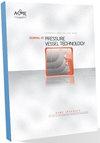Statistical Distribution Model of Charpy Absorbed Energy in Transition Temperature Range for Reactor Pressure Vessel Steel
IF 1.4
4区 工程技术
Q4 ENGINEERING, MECHANICAL
Journal of Pressure Vessel Technology-Transactions of the Asme
Pub Date : 2023-06-05
DOI:10.1115/1.4062674
引用次数: 0
Abstract
A statistical model to estimate the distribution characteristics of Charpy absorbed energy in the transition temperature range was proposed based on the variation in fracture toughness addressed by the Master Curve and the relationship between fracture toughness and Charpy absorbed energy associated with the Charpy Master Curve. Charpy absorbed energy in the transition temperature range can be well approximated by both the Weibull and normal distributions, and the parameters to determine the shape of the distributions (scale and shape parameters of the Weibull distribution, mean and standard deviation of the normal distribution) can be deductively defined as the functions of two independent variables, median of the fracture toughness and the difference between reference temperature and Charpy reference temperature. A series of Charpy impact tests were conducted under the same conditions to obtain the characteristics of the variation in Charpy absorbed energy for a reactor pressure vessel steel SQV2A base metal, and the experimental variation was reasonably predicted by the proposed model.反应堆压力容器钢在转变温度范围内夏比吸收能量的统计分布模型
基于主曲线处理的断裂韧性变化,以及与Charpy主曲线相关的断裂韧性与Charpy吸收能之间的关系,提出了估算转变温度范围内Charpy吸收能分布特征的统计模型。在转变温度范围内的Charpy吸收能量可以用Weibull分布和正态分布很好地近似,决定分布形状的参数(Weibull分布的尺度和形状参数,正态分布的均值和标准差)可以演绎定义为两个自变量的函数,断裂韧性的中位数和参考温度与Charpy参考温度之差。在相同条件下进行了一系列Charpy冲击试验,获得了反应堆压力容器钢SQV2A母材的Charpy吸收能量变化特征,并通过所建立的模型对实验变化进行了合理预测。
本文章由计算机程序翻译,如有差异,请以英文原文为准。
求助全文
约1分钟内获得全文
求助全文
来源期刊
CiteScore
2.10
自引率
10.00%
发文量
77
审稿时长
4.2 months
期刊介绍:
The Journal of Pressure Vessel Technology is the premier publication for the highest-quality research and interpretive reports on the design, analysis, materials, fabrication, construction, inspection, operation, and failure prevention of pressure vessels, piping, pipelines, power and heating boilers, heat exchangers, reaction vessels, pumps, valves, and other pressure and temperature-bearing components, as well as the nondestructive evaluation of critical components in mechanical engineering applications. Not only does the Journal cover all topics dealing with the design and analysis of pressure vessels, piping, and components, but it also contains discussions of their related codes and standards.
Applicable pressure technology areas of interest include: Dynamic and seismic analysis; Equipment qualification; Fabrication; Welding processes and integrity; Operation of vessels and piping; Fatigue and fracture prediction; Finite and boundary element methods; Fluid-structure interaction; High pressure engineering; Elevated temperature analysis and design; Inelastic analysis; Life extension; Lifeline earthquake engineering; PVP materials and their property databases; NDE; safety and reliability; Verification and qualification of software.

 求助内容:
求助内容: 应助结果提醒方式:
应助结果提醒方式:


